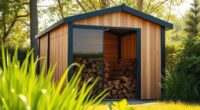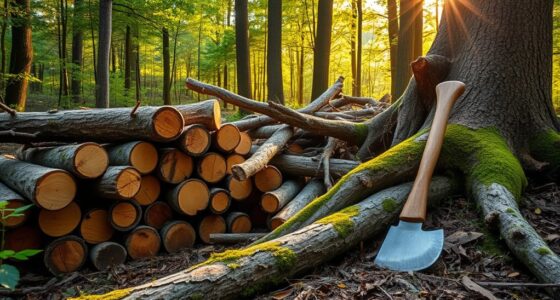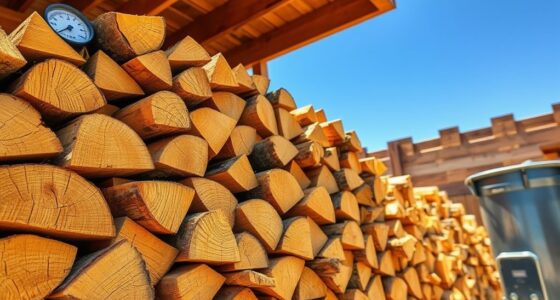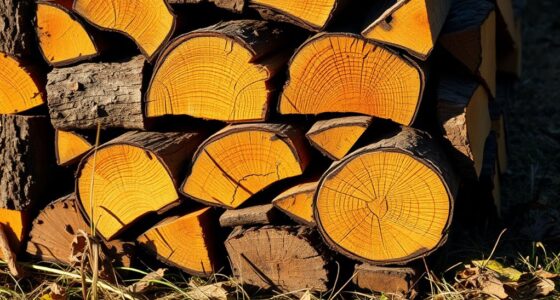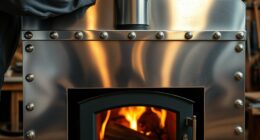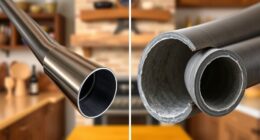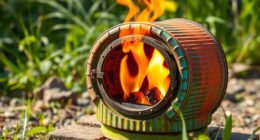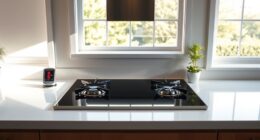Hardwood pellets, made from dense woods like oak or maple, burn cleaner, produce less ash, and last longer, making them eco-friendly and ideal if you want efficient, low-maintenance heating. Softwood pellets, from pine or spruce, are softer, burn slightly less efficiently, and need more frequent refueling but are often more abundant and easier to store. Blends mix both types, offering a balance of performance and storage flexibility; exploring these options helps you choose what best fits your needs.
Key Takeaways
- Hardwood pellets have higher energy content, burn cleaner, and produce less ash compared to softwood and blended pellets.
- Softwood pellets grow faster and are more abundant, making them potentially more sustainable but often with higher moisture content.
- Blended pellets combine hardwood and softwood, balancing environmental impact, storage needs, and burn performance.
- Hardwoods are denser and suitable for long-term storage, while softwoods require airtight storage due to higher moisture.
- The choice depends on environmental priorities, local availability, storage capacity, and desired burn efficiency.
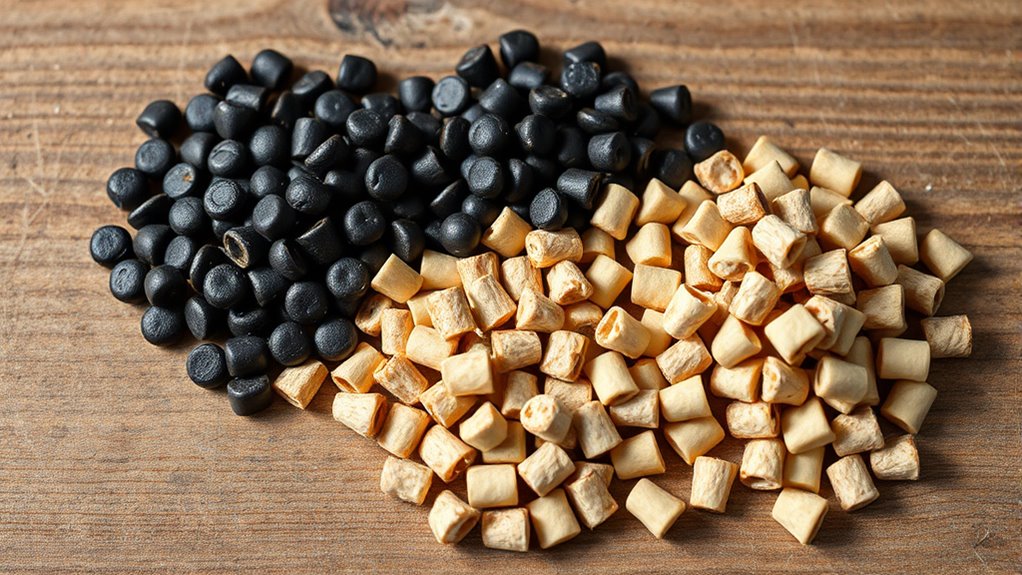
Are you wondering which pellet type suits your heating needs best? Choosing between hardwood, softwood, and blends can seem overwhelming at first, but understanding their differences helps you make the right decision. One of the key factors to consider is their environmental impacts. Hardwood pellets, made from dense woods like oak, maple, or hickory, tend to have a higher energy content per unit and produce less ash, making them a more eco-friendly choice overall. They burn cleaner and more efficiently, contributing less to air pollution and greenhouse gases. Softwood pellets, derived from woods like pine, spruce, or fir, are generally more abundant and grow faster, which can make them more sustainable depending on forestry practices. However, they often produce more ash and may burn a bit less efficiently, impacting their environmental footprint slightly. Blended pellets combine both hardwood and softwood, aiming to balance environmental impacts and performance, but their sustainability depends heavily on the sourcing and manufacturing process.
Storage requirements are another crucial aspect to consider when selecting pellet types. Hardwood pellets are usually denser and have a lower moisture content, which means they store well for longer periods without degradation. They require a dry, well-ventilated space to prevent mold or deterioration, but their resilience makes them a popular choice for long-term storage. Softwood pellets, being lighter and often containing higher moisture content, need more careful storage to prevent mold growth or spoilage. They should be kept in airtight containers or covered areas to maintain their quality over time. Blends can have varied storage needs depending on their composition; some may be more susceptible to moisture, so proper storage becomes even more crucial to ensure optimal performance. Additionally, the tuning of pellet stoves can influence how efficiently each type burns, impacting both performance and environmental footprint.
When weighing your options, think about your heating priorities and how much space you have for storage. Hardwood pellets might be a better fit if you’re looking for a cleaner burn and less frequent refilling, but you’ll need a dry, ventilated area to store them properly. Softwood pellets could be suitable if you have limited storage space and are okay with more frequent reloading, provided you manage moisture carefully. Blends offer a middle ground, often designed to optimize both environmental impacts and storage flexibility. Ultimately, your choice should align with your local availability, environmental values, and storage capabilities, ensuring you get the best performance from your pellet stove or boiler while minimizing ecological footprints.
Frequently Asked Questions
Which Pellet Type Offers the Best Caloric Value?
Hardwood pellets offer the best caloric value because they have higher energy density and calorific efficiency than softwood or blends. You’ll notice they produce more heat per unit, making them more cost-effective and efficient for your heating needs. Their dense composition ensures better combustion, so you get maximum heat output. If you’re aiming for ideal energy density and calorific efficiency, hardwood pellets are your best choice for consistent, powerful heat.
How Do Moisture Levels Vary Among Pellet Types?
You’ll find that moisture content varies among pellet types, affecting storage stability. Hardwood pellets typically have lower moisture levels, making them more stable and less prone to mold or spoilage during storage. Softwood pellets often have slightly higher moisture content, which can impact their shelf life. Blends fall somewhere in between. To maximize storage stability, keep your pellets in a dry, airtight environment, regardless of the type.
Are There Environmental Differences in Pellet Production?
Did you know that pellet production accounts for around 15% of global renewable energy use? You’ll find environmental differences in pellet production, especially with sustainable sourcing practices that reduce deforestation. Softwood pellets often have a lower emissions impact due to faster growth and easier processing, making them more eco-friendly. Choosing sustainably sourced pellets helps lower your carbon footprint and supports responsible forest management, making your heating more environmentally conscious.
Which Pellets Produce the Least Ash?
Hardwood pellets produce the least ash, making them ideal if you’re after cleaner pellet combustion. Their low ash content results in less residue, which means your pellet stove stays cleaner longer. You’ll notice that hardwood pellets have better pellet cleanliness overall, reducing maintenance. Softwood pellets tend to create more ash, so if minimal ash is your priority, hardwood is your best choice.
What Are the Storage Requirements for Each Pellet Type?
Ever wondered how to keep your pellets fresh? You should store each type in a cool, dry place to maintain ideal storage conditions. Keep them in airtight containers or sealed bags to prevent moisture absorption, which can shorten their pellet shelf life. Hardwood, softwood, and blends all require similar storage conditions, but softwoods may need extra protection due to their softer nature. Proper storage ensures your pellets burn efficiently every time.
Conclusion
Now that you’ve explored hardwood, softwood, and blends, you’re better equipped to choose the right pellet for your needs. Each type offers unique benefits, whether it’s warmth, efficiency, or sustainability. Remember, the right pellet can make your heating experience feel like a cozy scene from a Jane Austen novel—timeless and comforting. So, weigh your options carefully and enjoy the warmth, whether you’re in a modern home or a castle fit for a knight of the round table.


